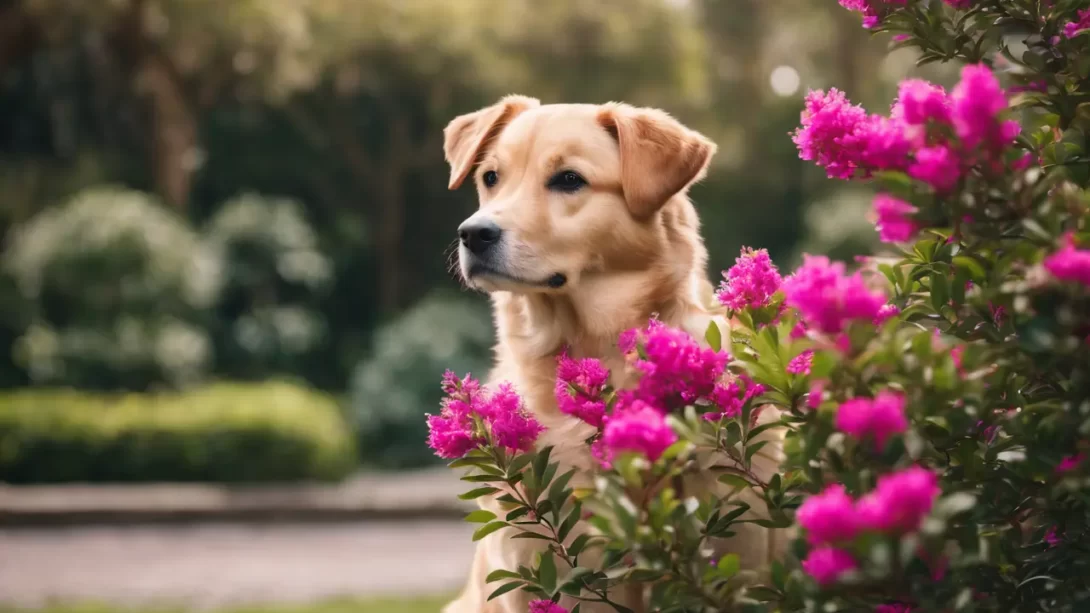Crepe myrtles (Lagerstroemia), renowned for their vibrant blooms and smooth, peeling bark, are a staple in many gardens. They add a splash of color and elegance, particularly in the warmer months. However, for dog owners, the safety of garden plants is a primary concern. Understanding which plants are safe and which pose a risk is essential for creating a pet-friendly garden. This article delves into the specific question: Are crepe myrtles toxic to dogs?
Crepe Myrtles
Crepe myrtles are admired for their long-lasting flowers, which bloom in shades of pink, red, purple, and white. These deciduous trees and shrubs are native to Asia and are widely cultivated in various parts of the world, especially in warmer climates. Beyond their flowers, crepe myrtles are known for their attractive, exfoliating bark and their ability to thrive in challenging conditions, making them popular choices for urban and suburban landscaping. There are numerous varieties, ranging from dwarf shrubs to tall trees, allowing gardeners to choose the perfect type for their space.
Toxicity Concerns in Plants
When incorporating plants into a garden where pets roam, understanding potential toxicity is crucial. Many common garden plants, while beautiful, can be harmful to dogs if ingested. The toxic compounds in these plants can range from mild irritants to severe toxins, leading to a variety of symptoms. Symptoms of plant toxicity in dogs can include vomiting, diarrhea, lethargy, and, in severe cases, organ failure or death. Knowing which plants are safe and which are not can help prevent accidental poisonings and ensure a safe environment for your furry friends.
Are Crepe Myrtles Toxic to Dogs?
Contrary to many other popular garden plants, crepe myrtles are generally considered non-toxic to dogs. This is good news for pet owners who admire the beauty of these plants. There is limited research specifically addressing crepe myrtles and dogs, but the consensus among horticultural and veterinary experts is that these plants do not contain harmful substances that pose a risk to canine health. However, it’s always prudent to monitor your pets in the garden, as individual animals may have unique sensitivities or allergic reactions.
Symptoms of Poisoning in Dogs
While crepe myrtles are not known to be toxic, it’s important to be aware of general symptoms of plant poisoning in dogs. These can include excessive drooling, vomiting, diarrhea, a decrease in appetite, lethargy, and abnormal urination or defecation. In rare cases, more severe symptoms such as seizures or difficulty breathing can occur. If you suspect your dog has ingested a potentially harmful plant, immediate veterinary attention is crucial. Early intervention can make a significant difference in the outcome.
First Aid and Treatment
If you believe your dog has ingested a toxic plant, the first step is to remove any plant material from their mouth and prevent further consumption. Next, try to identify the plant ingested, as this will aid the veterinarian in treatment. It’s important not to induce vomiting or give any home remedies unless specifically instructed by a veterinarian. The best course of action is to contact your veterinarian or an emergency animal hospital immediately. They may advise you to bring your dog in for examination and treatment, which could include induced vomiting, administration of activated charcoal, IV fluids, or other supportive care depending on the severity of the symptoms.
Safer Gardening Practices with Pets
Creating a pet-safe garden goes beyond choosing non-toxic plants like crepe myrtles. It involves thoughtful planning and ongoing vigilance. Start by researching the plants you intend to include in your garden for any potential risks to pets. Consider using physical barriers, such as fences or raised beds, to restrict your pet’s access to certain areas. Also, training your dog to avoid certain spots or plants can be effective. Regularly removing fallen leaves, flowers, or seeds, which pets might be tempted to eat, helps minimize risk. Additionally, be mindful of garden products like fertilizers, pesticides, and mulches, as these can also pose hazards to pets.
Conclusion
In conclusion, crepe myrtles are a safe choice for dog owners who wish to beautify their gardens without compromising the safety of their pets. While these plants are generally non-toxic, it’s always advisable to keep an eye on pets when they are in areas with a variety of plants and garden products. By combining the beauty of plants like crepe myrtles with thoughtful garden practices, you can create a vibrant and safe environment for both your plants and your pets. Enjoy the splendor of your garden, knowing that your furry friends are safe to explore and enjoy the outdoor space alongside you.




